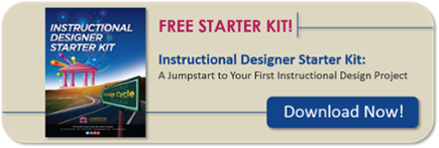
Photo by: Annie Spratt via Unsplash
Instructional Designers are constantly faced with the challenge of putting together solid performance-based training that sets learners up for success on the job. Their real-world circumstances are often less than ideal as they are consistently asked to work their magic with tight and unrealistic constraints. As training professionals, we know there is no magic wand, but we do have choices. One of those choices is blended learning. It offers the instructional designer a variety of strategies to choose from to help solve the complexities of the work environment’s training needs. There is no perfect blend of strategies, but there is a 3-step process we explore in our Blended Learning workshop that helps simplify the decision-making process.
Step 1: Identify Constraints
Before you choose a core strategy, like traditional instructor-led training or e-learning, you must first identify the instructional design constraints you are facing (e.g. time, budget, organizational mandates/policies, technical, design, etc.). This is a critical first step.
Step 2: Select Strategy
Once you have identified your constraints, it is time to consider the best core strategy (or strategies) that is most feasible for the type of content you are designing for. Will it be a traditional strategy, an e-learning strategy, or a combination? Not only do you need to assess the type of content, you will also need to consider other key factors such as the location of the learners, available resources, and deadlines, along with their implications.
Step 3: Consider Performance Support Activities
Unfortunately, we don’t live in an ideal world. Due to tight constraints, the instructional designer may need to incorporate Performance Support Activities (PSA’s) to support the core training strategy solution. While there’s a wide variety of PSA’s, some of the most common are coaching sessions, assigned reading, and group discussions and assessments.
Remember, there is no perfect blend. If you would like to explore best practices and dig a little deeper into the available strategies and options, I encourage you to register for our Blended Learning workshop. You may discover the ideal blend for you!
Note: This post is part of a workshop intersession activity. As such, it is monitored in a slightly different manner than the other blog posts on our website. If you are not a participant in the applicable workshop, but have a question you would like answered, please feel free to contact us.


64 Responses to “A 3-Step Decision-Making Process for Blended Learning”
I like the simplification into the three main points, and that they are broad and adaptable to situations that I may find myself in.
I really like the idea of using PSAs to ensure that low priority tasks are covered in the training. Due to time being a commonly seen constraint, I believe PSAs have the ability to free up valuable presentation and application/feedback time.
I look forward to leveraging the information provided in this blog and the larger workshop to drive my design work. Learning about the constraints, PSA, how to prioritize task, and more is essential in my journey to be the best Instructional Designer I can be.
I love that this approach truly utilizes PSAs as supplements to learning, allowing you to focus on the most important items and be able to justify these decisions with your clients. My current client is not a fan of pre- or post- work citing workloads that are already too heavy. They have asked that we try to fit everything into the class timeframe instead. Has anyone been successful in convincing their clients of the value of PSAs? If so, what were some of the key tenants you discussed with them?
This flexible model is a good construct to figure out how and when to use different training techniques.
I found that the key to discriminating between core training and performance support activities was the ability to prioritize tasks. Using the formula FR+LD+IM-(3*JE) was useful, but our team got stuck on the definition of Job Experience. If Job Experience only means how many times learners have done something, it isn’t very helpful. A learner may have repeatedly done the task poorly. (I have plenty of examples of tasks I have done poorly repeatedly, maybe we all do.) So, by changing the definition of JE to be “What level of job experience do learners have with MEETING THE BASIC STANDARD of each task?” our group was able to prioritize more clearly. In other words, agreeing on the definition of the largest component of the prioritization formula eased our burden. Thanks to Alan for helping us work through it!
Blended learning assists with making sure the material that never changes can be taught at the students pace and the other topics that change can be discussed in person. This is where the student can ask questions and get clarification.
Considering the constraints is absolutely necessary. This will certainly help with the stakeholders when responding to the request. With the constraints clearly identified, it helps to provide additional perspective to those making the request and justification for the learning approach.
Blended learning addresses the needs of all learners in all situations which may require one on one help, Instructor led formal training, access to physical or online job aids. It’s also easier to integrate what you have created into future trainings.
This is very interesting. I also believe that using a variety of training methods in one learning solution is a great way to keep learners engaged. It also promotes a better transfer of knowledge into different contexts.